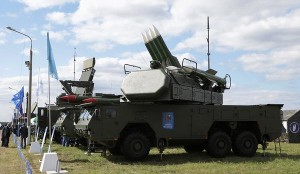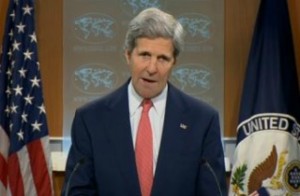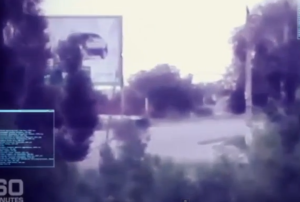More Game-Playing on MH-17?
by Robert Parry - Consortium News
May 24, 2016
A newly posted video showing a glimpse of a Buk missile battery rolling down a highway in eastern Ukraine has sparked a flurry of renewed accusations blaming Russia for the July 17, 2014 shoot-down of Malaysia Airlines Flight 17 killing 298 people. But the “dash-cam video” actually adds little to the MH-17 whodunit mystery because it could also support a narrative blaming the Ukrainian military for the disaster.
A screenshot of a Buk convoy, apparently traveling
eastward on highway H-21 in Makiivka, Ukraine,
on July 17, 2014, several hours before Malaysia
Airlines Flight 17 was shot down. (From a YouTube video)
The fleeting image of the missile battery and its accompanying vehicles, presumably containing an armed escort, seems to have been taken by a car heading west on H-21 highway in the town of Makiivka, as the convoy passed by heading east, according to the private intelligence firm Stratfor and the “citizen journalism” Web site, Bellingcat.
However, even assuming that this Buk battery was the one that fired the missile that destroyed MH-17, its location in the video is to the west of both the site where Almaz-Antey, the Russian Buk manufacturer, calculated the missile was fired, around the village of Zaroshchenskoye (then under Ukrainian government control), and the 320-square-kilometer zone where the Dutch Safety Board speculated the fateful rocket originated (covering an area of mixed government and rebel control).
In other words, the question would be where the battery stopped before firing one of its missiles, assuming that this Buk system was the one that fired the missile. (The map below shows the location of Makiivka in red, Almaz-Antey’s suspected launch site in yellow, and the general vicinity of the Dutch Safety Board’s 320-square-kilometer launch zone in green.)
Another curious aspect of this and the other eight or so Internet images of Buk missiles collected by Bellingcat and supposedly showing a Buk battery rumbling around Ukraine on or about July 17, 2014, is that they are all headed east toward Russia, yet there have been no images of Buks heading west from Russia into Ukraine, a logical necessity if the Russians gave a Buk system to ethnic Russian rebels or dispatched one of their own Buk military units directly into Ukraine, suspicions that Russia and the rebels have denied.
The absence of a westward-traveling Buk battery fits with the assessment from Western intelligence agencies that the several operational Buk systems in eastern Ukraine on July 17, 2014, were under the control of the Ukrainian military, a disclosure contained in a Dutch intelligence report released last October and implicitly confirmed by an earlier U.S. “Government Assessment” that listed weapons systems that Russia had given the rebels but didn’t mention a Buk battery.
The Netherlands’ Military Intelligence and Security Service (MIVD) reported that the only anti-aircraft weapons in eastern Ukraine capable of bringing down MH-17 at 33,000 feet on July 17 belonged to the Ukrainian government. MIVD made that assessment in the context of explaining why commercial aircraft continued to fly over the eastern Ukrainian battle zone in summer 2014.
MIVD said that based on “state secret” information, it was known that Ukraine possessed some older but “powerful anti-aircraft systems” capable of downing a plane at that altitude and “a number of these systems were located in the eastern part of the country,” whereas the MIVD said the ethnic Russian rebels had only MANPADS that could not reach the higher altitudes.
Ukrainian Offensive
On July 17, the Ukrainian military also was mounting a strong offensive against rebel positions to the north and thus the front lines were shifting rapidly, making it hard to know exactly where the borders of government and rebel control were. To the south, where the Buk missile was believed fired, the battle lines were lightly manned and hazy – because of the concentration of forces to the north – meaning that an armed Buk convoy could probably move somewhat freely.
A photograph of a Russian BUK missile system that U.S.
Ambassador to
Ukraine Geoffrey Pyatt published on Twitter
in support of a claim about
Russia placing BUK missiles in
eastern Ukraine, except that the image
appears to be an
AP photo taken at an air show near Moscow two years
earlier
Also, because of the offensive, the Ukrainian government feared a full-scale Russian invasion to prevent the annihilation of the rebels, explaining why Kiev was dispatching its Buk systems toward the Russian border, to defend against potential Russian air strikes.
Just a day earlier, a Ukrainian fighter flying along the border was shot down by an air-to-air missile (presumably fired by a Russian warplane), according to last October’s Dutch Safety Board report. So, tensions were high on July 17, 2014, when MH-17, flying from Amsterdam to Kuala Lumpur, broke apart over eastern Ukraine, believed downed by a surface-to-air missile although there have been other suggestions that the plane might have been hit by an air-to-air missile.
At the time, Ukraine also was the epicenter of an “information war” that had followed a U.S.-backed coup on Feb. 22, 2014, which ousted democratically elected President Viktor Yanukovych and replaced the Russian-friendly leader with a fiercely nationalistic and anti-Russian regime in Kiev. The violent coup, in turn, prompted Crimea to vote 96 percent in a hasty referendum to secede from Ukraine and rejoin Russia. Eastern Ukraine and its large ethnic Russian population also revolted against the new authorities.
The U.S. government and much of the Western media, however, denied there had been a coup in Kiev, hailed the new regime as “legitimate,” and deemed Crimea’s secession a “Russian invasion.” The West also denounced the eastern Ukrainian resistance as “Russian aggression.” So, the propaganda war was almost as hot as the military fighting, a factor that has further distorted the pursuit of truth about the MH-17 tragedy.
Immediately after the MH-17 crash, the U.S. government sought to pin the blame on Russia as part of a propaganda drive to convince the European Union to join in imposing economic sanctions on Russia for its “annexation” of Crimea and its support of eastern Ukrainians resisting the Kiev regime.
However, a source briefed by U.S. intelligence analysts told me that the analysts could find no evidence that the Russians had supplied the rebels with a sophisticated Buk system or that the Russians had introduced a Buk battery under their own command. The source said the initial intelligence suggested that an undisciplined Ukrainian military team was responsible.
Yet, on July 20, 2014, just three days after the tragedy, Secretary of State John Kerry appeared on all Sunday morning talk shows and blamed the Russian-backed rebels and implicitly Moscow. He cited some “social media” comments and – on NBC’s “Meet the Press” – added: “We picked up the imagery of this launch. We know the trajectory. We know where it came from. We know the timing. And it was exactly at the time that this aircraft disappeared from the radar.”
Two days later, on July 22, the Obama administration released a “Government Assessment” that tried to bolster Kerry’s accusations, in part, by listing the various weapons systems that U.S. intelligence believed Russia had provided the rebels, but a Buk battery was not among them. At background briefings for selected mainstream media reporters, U.S. intelligence analysts struggled to back up the administration’s case against Russia.
For instance, the analysts suggested to a Los Angeles Times reporter that Ukrainian government soldiers manning the suspected Buk battery may have switched to the rebel side before firing the missile. The Times wrote: “U.S. intelligence agencies have so far been unable to determine the nationalities or identities of the crew that launched the missile. U.S. officials said it was possible the SA-11 [Buk anti-aircraft missile] was launched by a defector from the Ukrainian military who was trained to use similar missile systems.”
However, after that July 22 briefing — as U.S. intelligence analysts continued to pore over satellite imagery, telephonic intercepts and other data to refine their understanding of the tragedy — the U.S. government went curiously silent, refusing to make any updates or adjustments to its initial rush to judgment, a silence that has continued ever since.
Staying Silent
Meanwhile, the source who continued receiving briefings from the U.S. intelligence analysts told me that the reason for going quiet was that the more detailed evidence pointed toward a rogue element of the Ukrainian military connected to a hardline Ukrainian oligarch, with the possible motive the shooting down of President Vladimir Putin’s plane returning from a state visit to South America.
In that scenario, a Ukrainian fighter jet in the vicinity (as reported by several eyewitnesses on the ground) was there primarily as a spotter, seeking to identify the target. But Putin’s plane, with similar markings to MH-17, took a more northerly route and landed safely in Moscow.
A side-by-side comparison of the Russian presidential
jetliner and the Malaysia Airlines plane.
Though I was unable to determine whether the source’s analysts represented a dissenting or consensus opinion inside the U.S. intelligence community, some of the now public evidence could fit with that narrative, including why the suspected Buk system was pushing eastward as close to or even into “rebel” territory on July 17.
If Putin was the target, the attackers would need to spread immediate confusion about who was responsible to avoid massive retaliation by Moscow. A perfect cover story would be that Putin’s plane was shot down accidentally by his ethnic Russian allies or even his own troops, the ultimate case of being hoisted on his own petard.
Such a risky operation also would prepare disinformation for release after the attack to create more of a smokescreen and to gain control of the narrative, including planting material on the Internet to be disseminated by friendly or credulous media outlets.
The Ukrainian government has denied having a fighter jet in the air at the time of the MH-17 shoot-down and has denied that any of its Buk or other anti-aircraft systems were involved.
Yet, whatever the truth, U.S. intelligence clearly knows a great deal more than it has been willing to share with the public or even with the Dutch-led investigations. Last October, more than a year after the shoot-down, the Dutch Safety Board was unable to say who was responsible and could only approximate the location of the missile firing inside a 320-square-kilometer area, whereas Kerry had claimed three days after the crash that the U.S. government knew the launch point.
Earlier this year, Fred Westerbeke, the chief prosecutor of the Dutch-led Joint Investigative Team [JIT], provided a partial update to the Dutch family members of MH-17 victims, explaining that he hoped to have a more precise fix on the firing site by the second half of 2016, i.e., possibly more than two years after the tragedy.
Westerbeke’s letter acknowledged that the investigators lacked “primary raw radar images” which could have revealed a missile or a military aircraft in the vicinity of MH-17. That apparently was because Ukrainian authorities had shut down their primary radar facilities supposedly for maintenance, leaving only secondary radar which would show commercial aircraft but not military planes or rockets.
Russian officials have said their radar data suggest that a Ukrainian warplane might have fired on MH-17 with an air-to-air missile, a possibility that is difficult to rule out without examining primary radar which has so far not been available. Primary radar data also might have picked up a ground-fired missile, Westerbeke wrote.
“Raw primary radar data could provide information on the rocket trajectory,” Westerbeke wrote.
“The JIT does not have that information yet. JIT has questioned a member of the Ukrainian air traffic control and a Ukrainian radar specialist. They explained why no primary radar images were saved in Ukraine.”
Westerbeke said investigators are also asking Russia about its data.
Westerbeke added that the JIT had “no video or film of the launch or the trajectory of the rocket.” Nor, he said, do the investigators have satellite photos of the rocket launch.
“The clouds on the part of the day of the downing of MH17 prevented usable pictures of the launch site from being available,” he wrote.
“There are pictures from just before and just after July 17th and they are an asset in the investigation.”
Though Westerbeke provided no details, the Russian military released a number of satellite images purporting to show Ukrainian government Buk missile systems north of the eastern Ukrainian city of Donetsk before the attack, including two batteries that purportedly were shifted 50 kilometers south of Donetsk on July 17, the day of the crash, and then removed by July 18.
Russian Lt. Gen. Andrey Kartopolov called on the Ukrainian government to explain the movements of its Buk systems and why Kiev’s Kupol-M19S18 radars, which coordinate the flight of Buk missiles, showed increased activity leading up to the July 17 shoot-down.
Necessary Secrets?
Part of the reason that the MH-17 mystery has remained unsolved is that the U.S. government insists that its satellite surveillance, which includes infrared detection of heat sources as well as highly precise photographic imagery, remains a “state secret” that cannot be made public.
Secretary of State John Kerry denounces Russia’s
RT network as a “propaganda bullhorn” during remarks
on April 24, 2014.
However, in similar past incidents, the U.S. government has declassified sensitive information. For instance, after a Soviet pilot accidentally shot down Korean Airlines Flight 007 over Russian territory in 1983, the Reagan administration revealed the U.S. capability to intercept Soviet ground-to-air military communications in order to make the Soviets look even worse by selectively editing the intercepts to present the destruction of the civilian aircraft as willful.
In that case, too, the U.S. government let its propaganda needs overwhelm any commitment to the truth, as Alvin A. Snyder, who in 1983 was director of the U.S. Information Agency’s television and film division, wrote in his 1995 book, Warriors of Disinformation.
After KAL-007 was shot down, “the Reagan administration’s spin machine began cranking up,” Snyder wrote. “The objective, quite simply, was to heap as much abuse on the Soviet Union as possible. … The American media swallowed the U.S. government line without reservation.”
On Sept. 6, 1983, the Reagan administration went so far as to present a doctored transcript of the intercepts to the United Nations Security Council. “The perception we wanted to convey was that the Soviet Union had cold-bloodedly carried out a barbaric act,” Snyder wrote.
Only a decade later, when Snyder saw the complete transcripts — including the portions that the Reagan administration had excised — would he fully realize how many of the central elements of the U.S. presentation were lies.
Snyder concluded, “The moral of the story is that all governments, including our own, lie when it suits their purposes. The key is to lie first.” [For more details on the KAL-007 deception and the history of U.S. trickery, see Consortiumnews.com’s “A Dodgy Dossier on Syrian War.”]
Quinn Schansman, a dual U.S.-Dutch citizen killed aboard
Malaysia Airlines Flight 17 on July 17, 2014.
(Photo from Facebook)
In the MH-17 case, the Obama administration let Kerry present the rush to judgment fingering the Russians and the rebels but then kept all the evidence secret even though the U.S. government’s satellite capabilities are well-known. By refusing to declassify any information for the MH-17 investigation, Washington has succeeded in maintaining the widespread impression that Moscow was responsible for the tragedy without having to prove it.
The source who was briefed by U.S. intelligence analysts told me that the Obama administration considered “coming clean” about the MH-17 case in March, when Thomas Schansman, the Dutch father of the only American victim, was pleading for the U.S. government’s cooperation, but administration officials ultimately decided to keep quiet because to do otherwise would have “reversed the narrative.”
A screen shot of the roadway where the suspected
BUK missile battery
supposedly passed after the shoot-down
of Malaysia Airlines Flight 17 on
July 17, 2014.
(Image from Australian “60 Minutes” program)
In the meantime, outfits such as Bellingcat have been free to reinforce the impression of Russian guilt, even as some of those claims have proved false. For instance, Bellingcat directed a news crew from Australia’s “60 Minutes” to a location outside Luhansk (near the Russian border) that the group had identified as the site for the “getaway video” showing a Buk battery with one missile missing.
The “60 Minutes” crew went to the spot and pretended to be at the place shown in the video, but none of the landmarks matched up, which became obvious when screen grabs of the video were placed next to the scene of the Australian crew’s stand-upper. [See Consortiumnews.com’s “Fake Evidence Blaming Russia for MH-17.”]
Correspondent Michael Usher of Australia’s “60 Minutes”
claims to have
found the billboard visible in a video
of a BUK missile launcher after
the shoot-down of
Malaysia Airlines Flight 17 on July 17, 2014.
(Screen
shot from Australia’s “60 Minutes”)
Yet, reflecting the deep-seated mainstream media bias on the MH-17 case, the Australian program reacted angrily to my pointing out the obvious discrepancies. In a follow-up, the show denounced me but could only cite a utility pole in its footage that looked similar to a utility pole in the video.
While it’s true that utility poles tend to look alike, in this case none of the surroundings did, including the placement of the foliage and a house shown in the video that isn’t present in the Australian program’s shot. [For details, see Consortiumnews.com’s “A Reckless Stand-upper on MH-17.”]
But the impact of the nearly two years of one-sided coverage of the MH-17 case in the mainstream Western media has been considerable. In the last few days, a lawyer for the families of Australian victims announced the filing of a lawsuit against Russia and Putin in the European court for human rights seeking compensation of $10 million per passenger. Many of the West’s news articles on the lawsuit assume Russia’s guilt.
In other words, whatever the truth about the MH-17 shoot-down, the tragedy has proven to be worth its weight in propaganda gold against Russia and Putin, even as the U.S. government hides the actual proof that might show exactly who was responsible.
(Research by Assistant Editor Chelsea Gilmour.)
Investigative reporter Robert Parry broke many of the Iran-Contra stories for The Associated Press and Newsweek in the 1980s. You can buy his latest book, America’s Stolen Narrative, either in print here or as an e-book (from Amazon and barnesandnoble.com).








No comments:
Post a Comment